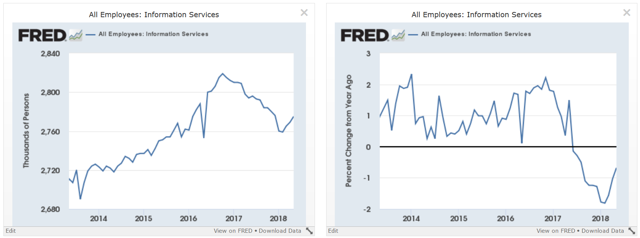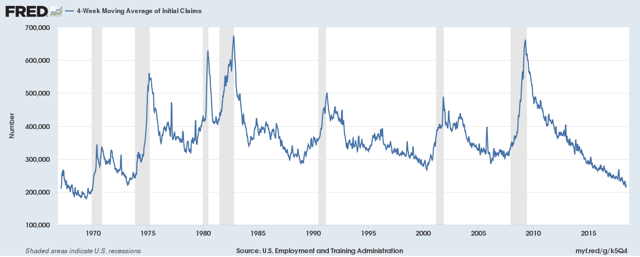Summary
The employment/population ratio is increasing, indicating people are getting pulled in from the sidelines.
The 3, 6, and 12-month moving averages of monthly establishment job growth are all near 200,000 - an incredibly strong pace.
Wages remain the primary weak area.
While all economic numbers tell us important information about the underlying economy, the monthly employment report is still the most important data for two reasons. First, labor is the largest expense for most companies, so an increase indicates that executives are bullish on the future (this explains why labor is used in the total product curve in microeconomics). Second, full-time employees are usually the last thing that a company will add in response to an increase in demand. They'll first increase the hours of existing employees and then add temporary workers before increasing their staff.
Right now, the US labor market is in incredibly good shape.
Let's start with three key measurements from the household survey:

The U-3 unemployment rate (above in blue) is the most often cited employment statistics. It was 3.8% in the latest employment report - one of the lowest levels in the last 30 years. The broader U-6 rate (which includes people marginally attached to the labor force and those working part-time for economic reasons) has been declining since its peak of nearly 17.5% at the end of the recession; it is currently right about 7.5%.
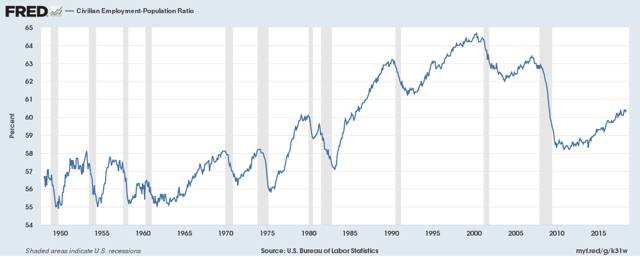
The employment/population ration - which measures the number of employed and unemployed people relative to the civilian non-institutional population - is increasing. This means that jobs market is pulling people in from the sidelines - a very healthy development.
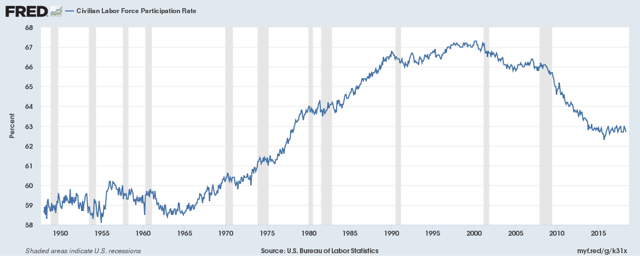
The decline in the labor force participation rate caught headlines at the beginning of this expansion as people argued that the weak economy was causing people to leave the labor force. This was partially true. But the primary reason for the decline was retiring baby-boomers, who are now leaving the working population at a rate of 10,000/day. Research from a number of Federal Reserve Banks has shown that this is the primary reason for the drop in the LFPR. That fact that it has leveled out these last few years indicates further stabilization in the labor market.
Let's turn to the establishment survey, starting with the payrolls number:
The top chart shows total payrolls, which are in a clear uptrend. The bottom chart uses the same data but converts it into 3-, 6-, and 12-month moving averages, which removes monthly variability. Currently, all are clustering around the 200,000 level, which is a very strong rate for an economy nearing its 8th year of expansion.
Next, let's break the data down into manufacturing and service sectors:
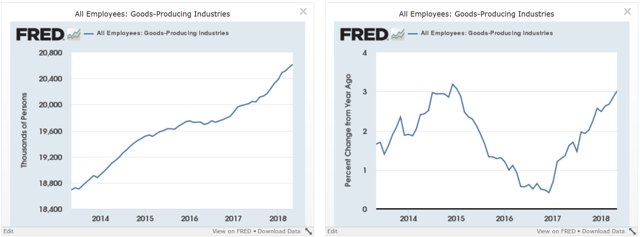
Goods-producing jobs (about 21% of total jobs) leveled off in the first half of 2016, largely as a result of the oil market collapse. But their pace of growth has been increasing strongly since early 2017. The Y/Y pace of growth has also been picking up.
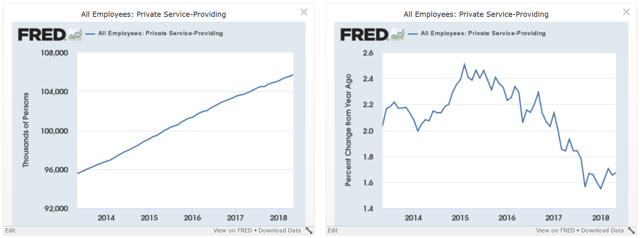 Service-sector jobs are also growing although the pace of Y/Y growth is declining. This is a simple function of math; as the underlying numbers increase in size, the pace of growth will naturally decrease unless the underlying absolute rate of change rises.
Service-sector jobs are also growing although the pace of Y/Y growth is declining. This is a simple function of math; as the underlying numbers increase in size, the pace of growth will naturally decrease unless the underlying absolute rate of change rises.
While most sectors are doing well, there are two areas of weakness:
Retail jobs (top chart) leveled off and then dropped a bit in 2017; they are currently increasing a bit. Information technology jobs (bottom chart) are contracting.
The primary leading indicator for the employment sector is in great shape:
The 4-week moving average of initial unemployment claims is at its lowest level in over 40 years.
The only weakness is the wage picture:

Wages are still weak.
All that being said, the overall condition of the labor market is very good.
Disclosure: I/we have no positions in any stocks mentioned, and no plans to initiate any positions within the next 72 hours.
I wrote this article myself, and it expresses my own opinions. I am not receiving compensation for it (other than from Seeking Alpha). I have no business relationship with any company whose stock is mentioned in this article.




